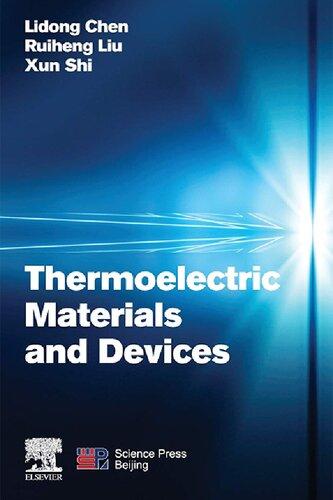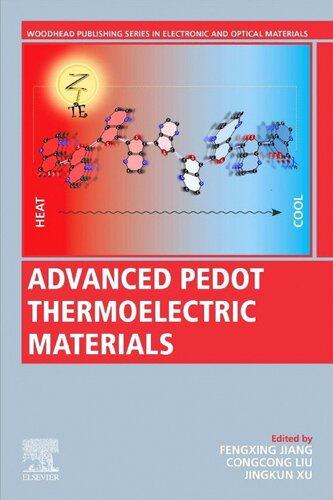The Technology of Discovery
Radioisotope Thermoelectric Generators and Thermoelectric Technologies for Space Exploration
Edited by
David Friedrich Woerner
Jet Propulsion Laboratory
California Institute of Technology, USA
This edition first published 2023 © 2023 John Wiley & Sons, Inc.
All rights reserved. No part of this publication may be reproduced, stored in a retrieval system, or transmitted, in any form or by any means, electronic, mechanical, photocopying, recording or otherwise, except as permitted by law. Advice on how to obtain permission to reuse material from this title is available at http://www.wiley.com/go/permissions.
The right of David Friedrich Woerner to be identified as the author of the editorial material in this work has been asserted in accordance with law.
Registered Office
John Wiley & Sons, Inc., 111 River Street, Hoboken, NJ 07030, USA
Editorial Office
9600 Garsington Road, Oxford, OX4 2DQ, UK
For details of our global editorial offices, customer services, and more information about Wiley products visit us at www.wiley.com.
Wiley also publishes its books in a variety of electronic formats and by print-on-demand. Some content that appears in standard print versions of this book may not be available in other formats.
Trademarks: Wiley and the Wiley logo are trademarks or registered trademarks of John Wiley & Sons, Inc. and/or its affiliates in the United States and other countries and may not be used without written permission. All other trademarks are the property of their respective owners. John Wiley & Sons, Inc. is not associated with any product or vendor mentioned in this book.
Limit of Liability/Disclaimer of Warranty
While the publisher and authors have used their best efforts in preparing this work, they make no representations or warranties with respect to the accuracy or completeness of the contents of this work and specifically disclaim all warranties, including without limitation any implied warranties of merchantability or fitness for a particular purpose. No warranty may be created or extended by sales representatives, written sales materials or promotional statements for this work. The fact that an organization, website, or product is referred to in this work as a citation and/or potential source of further information does not mean that the publisher and authors endorse the information or services the organization, website, or product may provide or recommendations it may make. This work is sold with the understanding that the publisher is not engaged in rendering professional services. The advice and strategies contained herein may not be suitable for your situation. You should consult with a specialist where appropriate. Further, readers should be aware that websites listed in this work may have changed or disappeared between when this work was written and when it is read. Neither the publisher nor authors shall be liable for any loss of profit or any other commercial damages, including but not limited to special, incidental, consequential, or other damages.
Library of Congress Cataloging-in-Publication Data
Names: Woerner, David Friedrich, editor.
Title: The technology of discovery : radioisotope thermoelectric generators and thermoelectric technologies for space exploration / David Frederich Woerner.
Description: Hoboken, NJ : Wiley, 2023. | Includes bibliographical references and index.
Identifiers: LCCN 2022051673 (print) | LCCN 2022051674 (ebook) | ISBN 9781119811367 (hardback) | ISBN 9781119811374 (adobe pdf) | ISBN 9781119811381 (epub)
Subjects: LCSH: Thermoelectric generators. | Radioisotopes in astronautics. | Thermoelectric apparatus and appliances. | Outer space–Exploration.
Classification: LCC TK2950 .W647 2023 (print) | LCC TK2950 (ebook) | DDC 621.31/243–dc23/eng/20221108
LC record available at https://lccn.loc.gov/2022051673
LC ebook record available at https://lccn.loc.gov/2022051674
Cover Design: Wiley
Cover Images: © NASA/JPL-Caltech/Malin Space Science Systems Set in 9.5/12.5pt STIXTwoText by
Contents
Foreward xi
Note from the Series Editor xiii
Preface xv
Authors xix
Reviewers xxi
Acknowledgments xxiii
Glossary xxv
List of Acronyms and Abbreviations xxxiii
1 The History of the Invention of Radioisotope Thermoelectric Generators (RTGs) for Space Exploration 1
Chadwick D. Barklay
References 5
2 The History of the United States’s Flight and Terrestrial RTGs 7
Andrew J. Zillmer
2.1 Flight RTGs 7
2.1.1 SNAP Flight Program 7
2.1.1.1 SNAP-3 8
2.1.1.2 SNAP-9 8
2.1.1.3 SNAP-19 9
2.1.1.4 SNAP-27 11
2.1.2 Transit-RTG 13
2.1.3 Multi-Hundred-Watt RTG 13
2.1.4 General Purpose Heat Source RTG 15
2.1.4.1 General Purpose Heat Source 15
2.1.4.2 GPHS-RTG System 16
2.1.5 Multi-Mission Radioisotope Thermoelectric Generator 17
2.1.6 US Flight RTGs 18
2.2 Unflown Flight RTGs 18
2.2.1.1 SNAP-1 18
2.2.1.2 SNAP-11 18
2.2.1.3 SNAP-13 18
2.2.1.4 SNAP-17 22
2.2.1.5 SNAP-29 22
2.2.1.6 Selenide Isotope Generator 23
2.2.1.7 Modular Isotopic Thermoelectric Generator 24
2.2.1.8 Modular RTG 24
2.3 Terrestrial RTGs 25
2.3.1 SNAP Terrestrial RTGs 25
2.3.1.1 SNAP-7 25
2.3.1.2 SNAP-15 26
2.3.1.3 SNAP-21 26
2.3.1.4 SNAP-23 26
2.3.2 Sentinel 25 and 100 Systems 27
2.3.3 Sentry 28
2.3.4 URIPS-P1 28
2.3.5 RG-1 29
2.3.6 BUP-500 30
2.3.7 Millibatt-1000 31
2.4 Conclusion 31
References 31
3 US Space Flights Enabled by RTGs 35 Young H. Lee and Brian K. Bairstow
3.1 SNAP-3B Missions (1961) 35
3.1.1 Transit 4A and Transit 4B 35
3.2 SNAP-9A Missions (1963–1964) 36
3.2.1 Transit 5BN-1, 5BN-2, and 5BN-3 36
3.3 SNAP-19 Missions (1968–1975) 38
3.3.1 Nimbus-B and Nimbus III 38
3.3.2 Pioneer 10 and 11 41
3.3.3 Viking 1 and 2 Landers 43
3.4 SNAP-27 Missions (1969–1972) 45
3.4.1 Apollo 12–17 45
3.5 Transit-RTG Mission (1972) 47
3.5.1 TRIAD 47
3.6 MHW-RTG Missions (1976–1977) 48
3.6.1 Lincoln Experimental Satellites 8 and 9 48
3.6.2 Voyager 1 and 2 50
3.7 GPHS-RTG Missions (1989–2006) 52
3.7.1 Galileo 52
3.7.2 Ulysses 53
3.7.3 Cassini 55
3.7.4 New Horizons 57
3.8 MMRTG Missions: (2011-Present (2021)) 59
3.8.1 Curiosity 59
3.8.2 Perseverance 61
3.8.3 Dragonfly–Scheduled Future Mission 62
3.9 Discussion of Flight Frequency 64
3.10 Summary of US Missions Enabled by RTGs 73 References 74
4 Nuclear Systems Used for Space Exploration by Other Countries 77 Christofer E. Whiting
4.1 Soviet Union 77
4.2 China 81 References 82
5 Nuclear Physics, Radioisotope Fuels, and Protective Components 85 Michael B.R. Smith, Emory D. Collins, David W. DePaoli, Nidia C. Gallego, Lawrence H. Heilbronn, Chris L. Jensen, Kaara K. Patton, Glenn R. Romanoski, George B. Ulrich, Robert M. Wham, and Christofer E. Whiting
5.1 Introduction 85
5.2 Introduction to Nuclear Physics 86
5.2.1 The Atom 86
5.2.2 Radioactivity and Decay 88
5.2.3 Emission of Radiation 90
5.2.3.1 Alpha Decay 91
5.2.3.2 Beta Decay 92
5.2.3.3 Photon Emission 92
5.2.3.4 Neutron Emission 93
5.2.3.5 Decay Chains 94
5.2.4 Interactions of Radiation with Matter 94
5.2.4.1 Charged Particle Interactions with Matter 96
5.2.4.2 Neutral Particle Interactions with Matter 97
5.2.4.3 Biological Interactions of Radiation with Matter 100
5.3 Historic Radioisotope Fuels 102
5.3.1 Polonium-210 104
5.3.2 Cerium-144 104
5.3.3 Strontium-90 105
8 Lifetime Performance of Spaceborne RTGs 183
Christofer E. Whiting and David Friedrich Woerner
8.1 Introduction 183
8.2 History of RTG Performance at a Glance 185
8.3 RTG Performance by Generator Type 189
8.3.1 SNAP-3B 189
8.3.2 SNAP-9A 189
8.3.3 SNAP-19B 191
8.3.4 SNAP-27 194
8.3.5 Transit-RTG 196
8.3.6 SNAP-19 197
8.3.7 Multi-Hundred Watt RTG 201
8.3.8 General Purpose Heat Source RTG 204
8.3.9 Multi-Mission RTG 207
References 210
9 Modern Analysis Tools and Techniques for RTGs 213
Christofer E. Whiting, Michael B.R. Smith, and Thierry Caillat
9.1 Analytical Tools for Evaluating Performance Degradation and Extrapolating Future Power 213
9.1.1 Integrated Rate Law Equation 214
9.1.2 Multiple Degradation Mechanisms 215
9.1.3 Solving for k′ and x 217
9.1.4 Integrated Rate Equation 220
9.1.5 Analysis of Residuals 220
9.1.6 Rate Law Equations: RTGs versus Chemistry versus Math 221
9.1.6.1 Application to RTG Performance 222
9.2 Effects of Thermal Inventory on Lifetime Performance 222
9.2.1 Analysis of GPHS-RTG 223
9.2.2 Analysis of MMRTG 226
9.3 (Design) Life Performance Prediction 228
9.3.1 RTG’s Degradation Mechanisms 229
9.3.2 Physics-based RTG Life Performance Prediction 233
9.4 Radioisotope Power System Dose Estimation Tool (RPS-DET) 235
9.4.1 Motivation 235
9.4.2 RPS-DET Software Components 236
9.4.3 RPS-DET Geometries 237
9.4.4 RPS-DET Source Terms and Radiation Transport 238
9.4.5 Simulation Results 239
9.4.6 Validation and Verification 240
9.4.7 Conclusion 240
References 241
Foreward
I am pleased to commend the Jet Propulsion Laboratory (JPL) Space Science and Technology Series, and to congratulate and thank the authors for contributing their time to these publications. It is not easy for busy scientists and engineers who face constant launch date and deadline pressures to find the time to tell others clearly and in detail how they solve important and difficult problems. So, I applaud the authors of this series for the time and care they devoted to documenting their contributions to the adventure of space exploration. In writing these books, these authors are truly living up to JPL’s core value of openness.
JPL has been NASA’s primary center for robotic planetary and deep-space exploration since the Laboratory launched the nation’s first satellite, Explorer 1, in 1958. In the years since this first success, JPL has sent spacecraft to each of the planets, studied our own planet in wavelengths from radar to visible, and observed the universe from radio to cosmic ray frequencies. Even more exciting missions are planned for the next decades in all these planetary and astronomical studies, and these future missions must be enabled by advanced technology that will be reported in this series. The JPL Deep Space Communications and Navigation book series captures the fundamentals and accomplishments of those two related disciplines. This companion Science and Technology Series expands the scope of those earlier publications to include other space science, engineering, and technology fields in which JPL has made important contributions.
I look forward to seeing many important achievements captured in these books.
Laurie Leshin, Director Jet Propulsion Laboratory California Institute of Technology
Note From the Series Editor
This title is the latest contribution to the Jet Propulsion Laboratory (JPL) Space Science and Technology Series. This series is a companion series of the ongoing Deep Space Communications and Navigation Systems (DESCANSO) Series and includes disciplines beyond communications and navigation. DESCANSO is a Center of Excellence formed in 1998 by the National Aeronautics and Space Administration (NASA) at JPL, which is managed under contract by the California Institute of Technology.
The JPL Space Science and Technology series, authored by scientists and engineers with many years of experience in their fields, lays a foundation for innovation by sharing state-of-the-art knowledge, fundamental principles and practices, and lessons learned in key technologies and science disciplines. We would like to thank the support of the Interplanetary Network Directorate at JPL for their encouragement and support of this series.
Jon Hamkins, Editor-in-Chief JPL Space Science and and Technology Series
Jet Propulsion Laboratory
California Institute of Technology
Preface
“Far better is it to dare mighty things, to win glorious triumphs, even though checkered by failure . . . than to rank with those poor spirits who neither enjoy nor suffer much, because they live in a gray twilight that knows not victory nor defeat.”
—Theodore Roosevelt
Radioisotope Thermoelectric Generators (RTGs) have proven to be one of the most creative solutions to the challenge of providing a reliable source of electrical power for deep space missions. RTGs have powered spacecraft that have discovered Ocean Worlds in our solar system, evidence that Mars harbored persistent liquid water in its ancient past, the largest known glacier in the solar system on Pluto, that Enceladus—a moon of Saturn—spouts icy plumes fed from a subterranean ocean, and given us our first taste of interstellar space.
This book is a history, primer, reference book, and partial record of what has become one of the most successful technologies ever fielded for the sake of space science, and an educated look at potential futures for RTGs. This title binds all of this together with an explanation of the basic physics of how RTGs are able to produce power from heat, along with discussions of specific programs, missions, failures, and more.
The history of RTG production has been episodic. The first RTG was invented during the Eisenhower administration in the 1950s and gave rise to frequent RTGpowered space missions in the 1960s and 1970s. However, in subsequent decades, the pace of missions that required this enabling technology waned to approximately the one to two launches per decade we see today. Production of various types of RTGs was stopped and restarted in concert with demand. This led to a dwindling of the industrial base and expertise required to produce these unique generators, and imprinted an ebb and flow or episodic pattern onto the production rate of RTGs over time.
Today, the US Department of Energy and NASA have formed a strong team using a “constant rate” approach to serve the demand and needs of a powerhungry community of space explorers. RTGs provide power where the sun does not shine regularly or strongly enough, and, we believe, RTGs will continue to be a vital power and energy source for complex deep space missions for generations to come. They are solid-state, quiet, extremely reliable, and long-lived.
The history of RTGs is glorious. That may sound like hyperbole, it is not. Some RTGs have been powering spacecraft in flight for over 45 years. No RTG has ever caused a mission or spacecraft failure. Their performance and lifetimes are unmatched by any other power source for spaceflight that humankind has mastered. They require no periodic maintenance in flight. RTGs are electrical generators that enable humankind to explore our darkest, dustiest, coldest regions of the solar system, and the vastness of the space outside of our sun’s minuscule heliosphere.
RTGs use materials that exhibit the Seebeck effect to convert heat into Direct Current (DC) electrical power. The Seebeck effect was first reported in 1823 by the Baltic German physicist Thomas Johann Seebeck. His discovery is the foundation for the technologies employed in RTGs for space missions using thermoelectric couples.
RTGs convert heat to power by directing heat flow through thermoelectric couples. Heated thermoelectric couples produce a voltage and when a load is applied, current will flow from each couple. Voila, DC electricity. Yet, RTGs are products of chemistry, materials science, nuclear physics, and decades of sophisticated engineering. They are solid-state, have no moving parts, and each is unitary, needing no ancillary equipment to produce power. Since their creation, extensive and well-funded research, engineering, and flight experience forged modern RTG designs for space exploration.
RTGs are not simple. They are annular in design and employ rings of thermoelectric couples arrayed around a stack of heat sources to convert heat to electricity. Drawings of them tend to unintentionally mask some of the internal components, some of which can reach temperatures over 1,000 degrees Centigrade or 1,832 degrees Fahrenheit, and are maintained at those temperatures for years. It is difficult to comprehend what happens to materials at those temperatures. Chemical reactions are vastly accelerated over our day-to-day experiences. Materials that are solid at room temperature may sublimate when heated to such temperatures. In addition, materials can diffuse into one another.
A schematic of a thermoelectric couple suggests simplicity and masks several phenomena, such as the dramatic temperature reduction between its hot- and cold-side components. For example, Figure 0.1 shows a silicon-germanium thermoelectric couple (aka unicouple), which comprises five subassemblies that
FIRSTBONDASSEMBLYSECONDBONDASSEMBLYCOUPLEPRE-ASSEMBLY
COLDSTACKASSEMBLY
HEAT SHUNT (Cu)
HOT SHOE (SiMo)
SPACER (AI2O3)
PELLET (78% SiGe)
SEGMENT (63% SiGe)
COLD SHOE (W)
PEDESTAL (Cu)
COMPENSATOR (W)
ELECTRICAL CONNECTOR (Cu)
ELECTRICAL INSULATOR (AI2O3)
COMPENSATOR (Mo)
PRESSURE PAD (SS)
Figure 0.1 A schematic of a silicon-germanium thermoelectric unicouple used in the GPHS-RTGs flown on the Cassini mission. Parenthetical letters refer to chemical elements or compounds. Credit: Lockheed Martin.
include eighteen separate components. During steady-state operation in today’s RTGs, the temperature along the length of this type of unicouple drops from 1,035 °C (1,895 °F) at the hot shoe to 290 °C (554 °F) at the heat shunt. That gradient stretches just over one inch and yields a temperature change of ~750 °C (~1,382 °F). This dramatic temperature gradient suggests deep, unobvious complexities tied to thermoelectric technologies and RTGs.
Insight into the unobvious is what you will discover in these pages and should provide the reader with enough RTG history to make them conversant, enough flight history to incorporate this knowledge into deep space mission designs, some background to inform policy and funding decisions, and comprehensive insights intended to help sidestep many of the failures of the past. We employed real-world examples throughout and applied theory to practical situations. We intend this book to bridge the gap between university studies and professional work. Therefore, we provide extensive lists of references to point readers to fundamental and referential sources.
The material herein complements and expands the public history of RTGs, explores the current state-of- the-art, and attempts to peer forward in time. We intend to provide more historical detail of both successes and failures, discuss
Preface
advances and setbacks of novel thermoelectric materials and technologies that scientists have investigated and abandoned, and chart possible courses to future RTGs and their technologies.
The reinvigorated search for life beyond Earth and NASA’s drive to install a permanent human presence on the Moon have breathed new life into space exploration, and each thrust will require technologies that operate effectively in cold and dark spaces. RTGs provide hope for these immediate goals and will enable many more important discoveries. It is a marvelous time to be exploring space!
David
Friedrich Woerner, Jet Propulsion Laboratory/California Institute of Technology, Pasadena, California, USA
Authors
Brian K. Bairstow
Jet Propulsion Laboratory/California Institute of Technology Pasadena California
Chadwick D. Barklay
University of Dayton Research Institute, Dayton, Ohio
Russell Bennett
Teledyne Energy Systems, Inc.
Hunt Valley, Maryland
Thierry Caillat
Jet Propulsion Laboratory/California Institute of Technology Pasadena, California
Ike C. Chi
Jet Propulsion Laboratory/California Institute of Technology Pasadena, California
Emory D. Collins
Oak Ridge National Laboratory
Oak Ridge, Tennessee
Shad E. Davis
Idaho National Laboratory
Idaho Falls, Idaho
David W. DePaoli
Oak Ridge National Laboratory Oak Ridge, Tennessee
Patrick E. Frye
Aerojet Rocketdyne Canoga Park, California
Nidia C. Gallego
Oak Ridge National Laboratory Oak Ridge, Tennessee
Lawrence H. Heilbronn University of Tennessee Knoxville, Tennessee
Tim Holgate
John Hopkins University Applied Physics Laboratory, Laurel, Maryland
Chris L. Jensen
Oak Ridge National Laboratory Oak Ridge, Tennessee
Steve Keyser
Teledyne Energy Systems, Inc. Hunt Valley, Maryland
Andrew M. Lane
Aerojet Rocketdyne Canoga Park, California
Authors xx
Young H. Lee
Jet Propulsion Laboratory/California Institute of Technology Pasadena, California
Jong-Ah Paik
Jet Propulsion Laboratory/California Institute of Technology Pasadena, California
Kaara K. Patton
Oak Ridge National Laboratory Oak Ridge, Tennessee
Brian Phan
Jet Propulsion Laboratory/California Institute of Technology Pasadena, California
Stan Pinkowski
Jet Propulsion Laboratory/California Institute of Technology Pasadena, California
Glenn R. Romanoski
Oak Ridge National Laboratory
Oak Ridge, Tennessee
Kevin L. Smith
Jet Propulsion Laboratory/California Institute of Technology Pasadena, California
Michael B.R. Smith
Oak Ridge National Laboratory
Oak Ridge, Tennessee
Ying Song
Teledyne Energy Systems, Inc. Hunt Valley, Maryland
George B. Ulrich
Oak Ridge National Laboratory Oak Ridge, Tennessee
Joe VanderVeer
Teledyne Energy Systems, Inc. Hunt Valley, Maryland
Hsin Wang
Oak Ridge National Laboratory, Oak Ridge, Tennessee
Karl A. Wefers
Aerojet Rocketdyne Canoga Park, California
Robert M. Wham
Oak Ridge National Laboratory Oak Ridge, Tennessee
Christofer E. Whiting
University of Dayton Research Institute Dayton, Ohio
David Friedrich Woerner
Jet Propulsion Laboratory/California Institute of Technology Pasadena, California
Andrew J. Zillmer
Idaho National Laboratory Idaho Falls, Idaho
Reviewers
Chadwick D. Barklay
University of Dayton Research Institute, Dayton, Ohio
Charles E. Benson
Jet Propulsion Laboratory/California Institute of Technology Pasadena, California
Thierry Caillat
Jet Propulsion Laboratory/California Institute of Technology Pasadena, California
Eric S. Clarke
Idaho National Laboratory Idaho Falls, Idaho
Joe C. Giglio
Idaho National Laboratory Idaho Falls, Idaho
Terry J. Hendricks
Retired—Jet Propulsion Laboratory/ California Institute of Technology Pasadena, California
Douglas M. Isbell
Jet Propulsion Laboratory/California Institute of Technology Pasadena, California
Stephen G. Johnson
Idaho National Laboratory Idaho Falls, Idaho
Vladimir Jovovic
Jet Propulsion Laboratory/California Institute of Technology Pasadena, California
Emily F. Klonicki
Jet Propulsion Laboratory/California Institute of Technology Pasadena, California
Christopher S. Matthes
Jet Propulsion Laboratory/California Institute of Technology Pasadena, California
Lucas T. Rich
Idaho National Laboratory Idaho Falls, Idaho
Glenn R. Romanoski
Oak Ridge National Laboratory Oak Ridge, Tennessee
Carl E. Sandifer
NASA Glenn Research Center Cleveland, Ohio
Acknowledgments
I wish to acknowledge my parents, Robert Woerner and Mary Crow. It is their devotion to me, love, and upbringing that made my participation in this project possible.
I want to thank Brett Kurzman and Stacey Woods, our editors, and their colleagues at Wiley.com. They were responsive, dedicated, patient, and extremely helpful in preparing this manuscript.
I want to thank the small army of women and men that made this publication possible, those tireless souls that founded, grew, and built the Radioisotope Power System community into what it is today. The list of their names could fill the pages of this book, and I struggled with who to single out and mention here and concluded I would err on the side of not slighting anyone and just say thank you to the entire RPS community. Thank you. Thank you. You gave me friends, companions, and a career I did not expect.
I am deeply humbled and fascinated by the work and achievements of the RPS community and hope that this manuscript does them at least some small amount of justice. I know the authors have poured their hearts into the book and deserve a round of applause.
I/we are indebted to the reviewers whose clarity of mind and perceptive insights kept us focused and out of the “ditch” of lousy writing.
Lastly, I want to thank those space exploring scientists and engineers who thrill the world with their fabulous discoveries. The draft of the next Planetary Science and Astrobiology Decadal Survey was released less than a handful of days before I typed these words. The draft promises that the search for past and present life in our solar system will continue. It describes new and exciting scientic missions to come in the next decade should Congress and NASA fund them. Several missions to destinations in our solar system are only achievable by RPS powered robots. Expect grand findings.
A portion of this research was carried out at the Jet Propulsion Laboratory, California Institute of Technology, under a contract with the National Aeronautics and Space Administration (80NM0018D0004).
Portions of this work were authored under the support of Oak Ridge National Laboratory managed UT- Battelle, LLC, under contract DE-AC05-00OR22725 with the US Department of Energy (DOE).
Portions of this work were authored thanks to the generous support of the University of Dayton Research Institute.
A portion of this research was carried out at the Idaho National Laboratory, under a contract with the US Department of Energy (DE-AC07-05ID14517).








